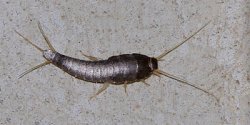Silverfish & Firebrats
 Silverfish (Lepisma saccharina) and firebrats (Thermobia domestica) cause damage in homes by eating foods and other materials that are high in protein, sugar or starch. They feed on cereals, moist flour, any paper on which there is glue or paste, sizing in paper including wall paper and book bindings, starch in clothing and rayon fabrics.
Silverfish (Lepisma saccharina) and firebrats (Thermobia domestica) cause damage in homes by eating foods and other materials that are high in protein, sugar or starch. They feed on cereals, moist flour, any paper on which there is glue or paste, sizing in paper including wall paper and book bindings, starch in clothing and rayon fabrics.
Silverfish and firebrats are slender-bodied, about ½ of an inch in length and wingless. Their bodies are covered with scales which are a shiny silver or pearl gray for silverfish, and mottled gray for firebrats. The immature insects look like the adults but are smaller in size. They both have two long antennae on the head and three long tail-like appendages at the hind end. Silverfish and firebrats are common in houses and structures throughout the United States. Silverfish live and develop in damp, cool places, especially basements and cellars. Firebrats live and develop in hot, dark places such as around furnaces, fireplaces and in insulation around hot water or heat pipes. Both are active at night and hide during the day.
Silverfish and firebrats develop slowly under usual household conditions and produce few young. They are able to live without food for several months. The females lay eggs during all seasons in secluded places such as behind books or on closet shelves. Silverfish lay eggs singly or only a few at a time, but may deposit several batches over a period of weeks. Firebrats deposit about 50 eggs at a time, and again, may lay several batches. Eggs hatch in a few weeks and the rate of growth of the young depends on the temperature and humidity in the building. Silverfish and firebrats may reach maturity in 3 to 24 months.
